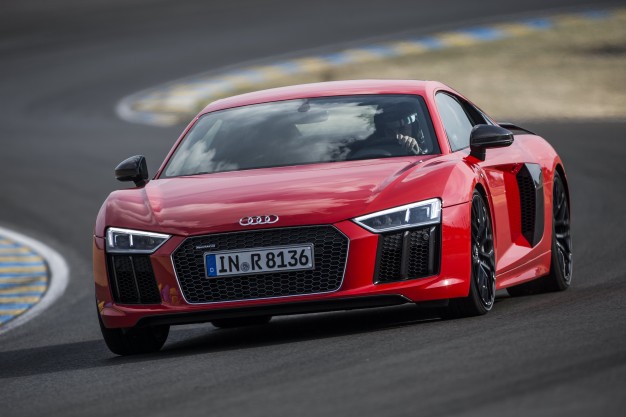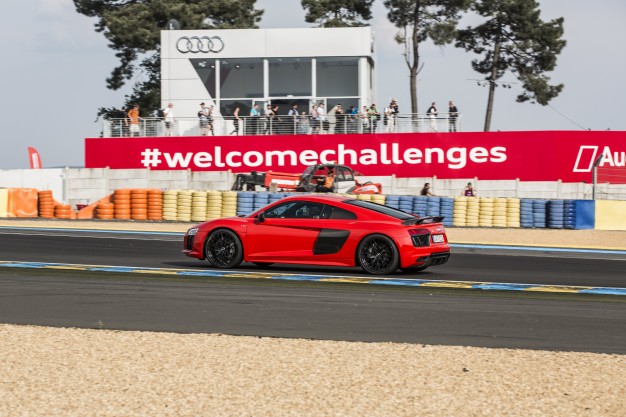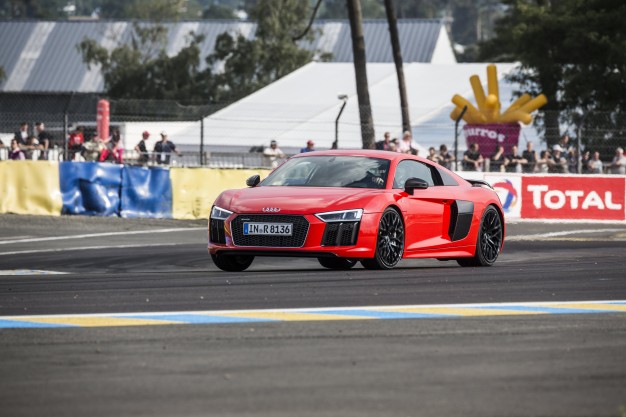
–
As your mother probably warned you, there’s only one chance to make a first impression. And Audi was clearly determined that our initial experience with the new R8 would be a memorable one.
–
The invitation was simple, and there wasn’t any chance of us turning it down: Come to Le Mans to watch the 24 Hours race and, during a break between practice and qualifying sessions, take the all-new R8 for a single lap of the track, a whole month before the international press drive. We said yes, obviously, but with just 8.4 miles of the Circuit de la Sarthe to make acquaintance, in dynamic assessment terms this is definitely an amuse bouche rather than a four-course feast with coffee and cognac to follow.
–
The drive was every bit as surreal as we secretly hoped it would be. But before that, a bit about the car itself. The new R8 looks very similar to the first generation, but is almost entirely new. It’s closely related to the Lamborghini Huracan, to a far greater extent than its predecessor’s kinship to the Gallardo, with both cars sharing the same basic structure including a carbon-fiber floor and rear bulkhead.
–
Engine choice has been simplified with the axing of the V-8. Now there’s just two V-10s, both developments of the old 5.2-liter engine, in standard 532-hp and 602-hp “Plus” forms. And, sad to report, the option of a manual gearbox is also gone; apparently just three percent of first-gen R8s were being ordered with it by the end of production. The seven-speed dual-clutch S Tronic transmission is reportedly tuned to deliver faster gear changes. All-wheel drive is again standard, but torque to the front wheels is now diverted via an electronically controlled clutch pack instead of the first R8’s viscous coupling.
–
The inevitable delays getting onto the track mean there’s plenty of time to make a considered assessment of the new R8’s cabin, which is a lovely place to spend time. Conventional instruments are gone, replaced—as in the new TT—by a screen that fills the binnacle and can be configured in several different modes. Many controls have migrated onto the steering wheel, which in addition to the usual thumb-wheels now contains buttons for the Drive Select mode, the ignition, the switchable exhaust, and one labeled with a checkered flag. Pressing this delivers your pre-saved dynamic preferences, similar to the M button in BMW M-cars.
–
–
–
–
–
With entirely predictable French unpredictability, we go from a bored run-through of the radio presets to having an angry marshal gesturing us onto the track within the space of about 10 seconds. The R8s are all Plus versions and are being sent out at the back of an esoteric pack of thrill seekers, including 911s from the Porsche Experience Center and some two-seat sports cars that are normally used to deliver passenger rides on the short Bugatti Circuit. There aren’t enough production-spec new R8s to go around, so two are official 24 Hours safety cars that will be used for the race itself, complete with flashing lights. Sad to relate, we didn’t get one of those.
–
On the circuit something close to chaos reigns. Every marshals’ post is waving yellow flags—with some marshals even standing well into the track to make the point that this is supposed to be a polite demonstration lap. But our pace car is an R8 LMS racer being driven by Tom Kristensen, and he sets off at the pace you’d expect from a nine-time Le Mans winner. It’s a good opportunity to confirm the new R8 is a seriously rapid machine, with acceleration feeling subjectively more brisk that that of the old R8 V10 Plus. The engine pulls happily to its 8500-rpm redline, with the whole instrument panel changing color when it’s time to upshift. The paddles behind the steering wheel feel light and placticky, but the shifts themselves are lightning-fast.
–

–
Reaching the main start-finish line brings the chance to navigate a couple of tight chicanes and delivers welcome proof that, behind Audi’s typically generous servo assistance, the new R8 stops as well as it goes—carbon-ceramic brakes are standard on the Plus model. But as with the Huracan, the electrically assisted steering feel overly light and—unlike the French themselves—short on meaningful resistance, especially when compared with the communicative helm of the old car. We spend much of the rest of the lap cycling among different Drive Select modes, which vary the weighting but don’t do anything to increase feedback.
–
The grandstands are still half full of fans who are either waiting for the later qualifying session or hoping to see somebody wreck an expensive new car. Which very nearly happens when one of the R8s ahead slows suddenly to a waving-to-the-crowds pace and narrowly avoids being rear-ended by the speeding safety car behind. Passing under the iconic Dunlop bridge is a moment that defies even our best attempts at professional cynicism. This leads to a demanding sequence of corners, with the marshals guarding this part of the track seeming to have adopted a far more laissez faire attitude than their counterparts. The pack increases its pace and the R8 demonstrates some impressive agility in the transitions between turns.
–
That brings us to the Mulsanne straight. It isn’t a straight anymore—it’s broken up by two chicanes that were put in to lower the ridiculous terminal speeds being achieved in the early 1990s, but the gaps between these are still long enough to establish that the new R8 is as fast as the implications its power and weight figures suggest—we see an indicated 260 km/h (161 mph) before braking for the first chicane. Upon entering it, we discover it’s having its barriers rebuilt by a crew who with their truck are blocking most of the track. It seems the yellow flags aren’t for show after all.
–

–
The chicanes, and the three moderately famous low-speed turns that follow—Mulsanne, Indianapolis, and Arnage—also demonstrate that the new R8 feels far more neutral under power. Even with the ESC switched into its more aggressive Sport mode, it takes without protest throttle inputs that would have slewed the back of the old car. It’s more sensible, certainly, and proof of the quick reactions of the electronic clutch pack, but also slightly less fun.
–
And that’s pretty much it. We’d love to be able to tell you what we learned from a flat-out blast through the Porsche Curves—apparently the car now generates positive downforce both front and rear at speed—but by the time we got there, going-slow guy had dropped back down to crowd-waving velocity again. And although the temptation to ignore the gesturing marshals and go for a second flying lap was great, we leave the track obediently with everyone else.
–
–
- –
- GR8 Daily R8s: Factory Rent-An-Audi Program Kicks Off in San Francisco
- 2016 Audi R8: We Ride In, and Detail, the Next Four-Ring Supercar
- Audi R8 Research: Full Pricing, Specs, Reviews, and More
–
–
–
–
–
So what have we learned? That Le Mans is a great track, and that even a single lap there definitely checks a box on the bucket list. And that the new R8 is very fast and very grippy and probably more grown-up than its predecessor. It sounds good too, although we can’t tell you anything about how it rides or shifts at low speed or deals with the challenge of doing anything other than going flat-out around a race track.
–
A great first impression, but we’re looking forward to that second date.
–




